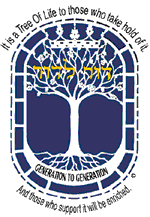|
|
The Story Of The Jewish Torahs of Czechoslovakia Chapter Two - Ralph C Yablon and London's Westminister Synagogue While Abramsky was still in Prague, Estorick discussed the problem of the Czech scrolls with one of his clients, Ralph C. Yablon, a well-to-do, public-spirited member of London's Westminister Synagogue. Yablon in turn contacted his rabbi, Harold F. Reinhart, who had been contemplating the idea of setting up a Holocaust memorial museum in his synagogue. Perhaps, the rabbi said, some of the Czech Torah scrolls could be brought to London as a nucleus for such an exhibit. Yablon's answer was to acquire all the 1,564 scrolls from Czechoslovakia for the equivalent of #30,000, and in December 1963 the Westminister Synagogue became the official trustee for the entire collection until such time as it could be distributed elsewhere. In addition to purchasing the scrolls for the Westminister Synagogue, Yablon supplied the funds for their packing and their transportation from Prague to London.
Meanwhile, the Westminister Synagogue had organized a Memorial Scrolls Committee, of which Frank R. Waley became chairman and Mrs. G.R. (Ruth) Shaffer, Honorary Secretary. When the scrolls, covered with transparent polyethylene plastic, began to arrive at the synagogue on February 5, 1964, their quarters were ready to receive them. Three rooms had been set aside for the scrolls on the second floor of Kent House, the synagogue annex. Special racks had been constructed, and each scroll, or scroll fragment, was numbered and placed into a compartment marked with the corresponding number. This process of sorting and registration alone consumed several months. The day-to-day care of the scrolls became a community-wide project, involving not only Rabbi Reinhart, his wife, and Mrs. Shaffer, but also representatives of other segments of London Jewry, including Chief Rabbi Israel Brodie (later Sir Israel Brodie); Dr. Solomon Gaon, the haham (chief rabbi) of the Sephardic community; Rabbi Pinhas Toledano, minister of the Wembley Sephardic congregation; and Richard D. Barnett, a prominent member of London's Spanish and Portuguese Synagogue and "Keeper" in the Department of Western Asiatic Antiquities in the British Museum. Rehabilitation Of The Scrolls Continues By the Summer of 1964, the Memorial Scrolls Committee could begin
the second step in the rehabilitation of the scrolls. With the cooperation
of Dr. Gaon and others, scribes were engaged to subject each scroll
to careful scrutiny from beginning to end and to record their findings
for each scroll---its history, place and ate of origin, distinguishing
features and, most important, the condition of the rollers, the
parchment, and the writing. On the basis of their condition, the
scrolls were classified into five categories. In the top category
were the Torahs in the "Best" condition, or those that
were fit for use at synagogue services without needing, or virtually
without needing, refurbishment. The bottom category they termed
as "Unusable". All the other Torah scrolls fit into the
middle three. "I shall never forget the look of astonishment and awe
on his (David Brand's) face when he saw those three rooms stacked
to the ceiling with sifre Torah (Torah scrolls)." Scrolls graded in between "Best" to "Unusable" required various minor and major repairs before they could be used for reading at synagogue services. It soon became clear that temporary, part-time scribes would not be sufficient for this work. A full-time scribe would be required, but the Westminister Synagogue had difficulty in finding a competent individual willing to devote all his time to examining and repairing the Czech scrolls. In May 1967 such a person was unexpectedly found at the very doorsteps of Kent House. He was David Brand, newly arrived from Jerusalem, who told Mrs. Shaffer that he had been traveling to many parts of the world repairing scrolls in synagogues and wondered whether the Westminister Synagogue happened to have any scrolls in need of repair. "I shall never forget the look of astonishment and awe on his face when he saw those three rooms stacked to the ceiling with sifre Torah (Torah scrolls), Mrs. Shaffer recalled. Initially, David worked for the Westminister Synagogue on a temporary
basis only, but after his wife and family came over from Israel
to join him in London, he agreed to give all his time to the Torah
scrolls from Czechoslovakia. |

© 1999-2006, The Czech Torah Network. All Rights Reserved.
The logo design was created by Risa Mandelberg and is being used with permission.
© 1997, the paperdoll company. All Rights Reserved.
For questions or comments about this Web site please e-mail The Czech Torah Network at czechtorah@aol.com.


